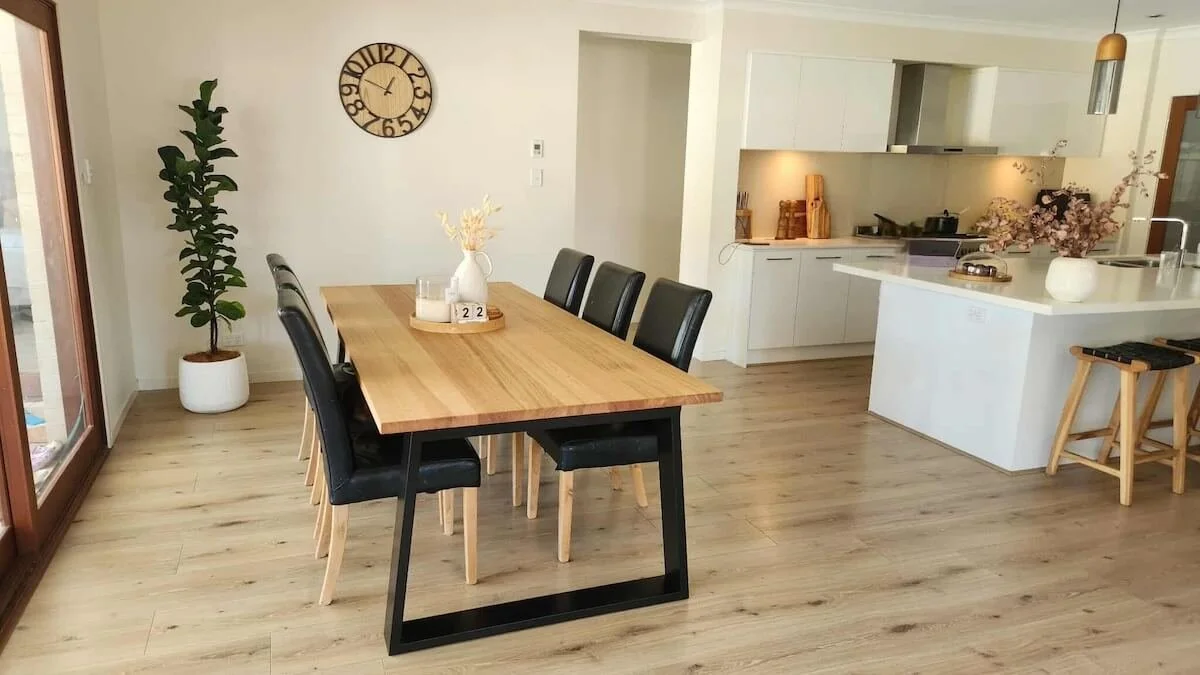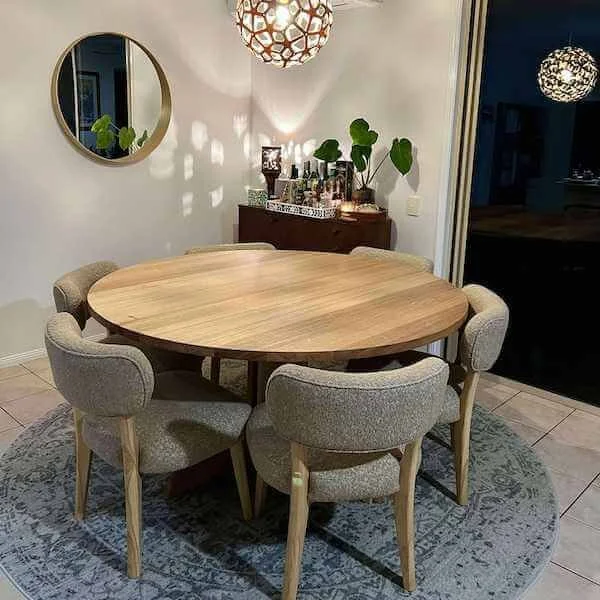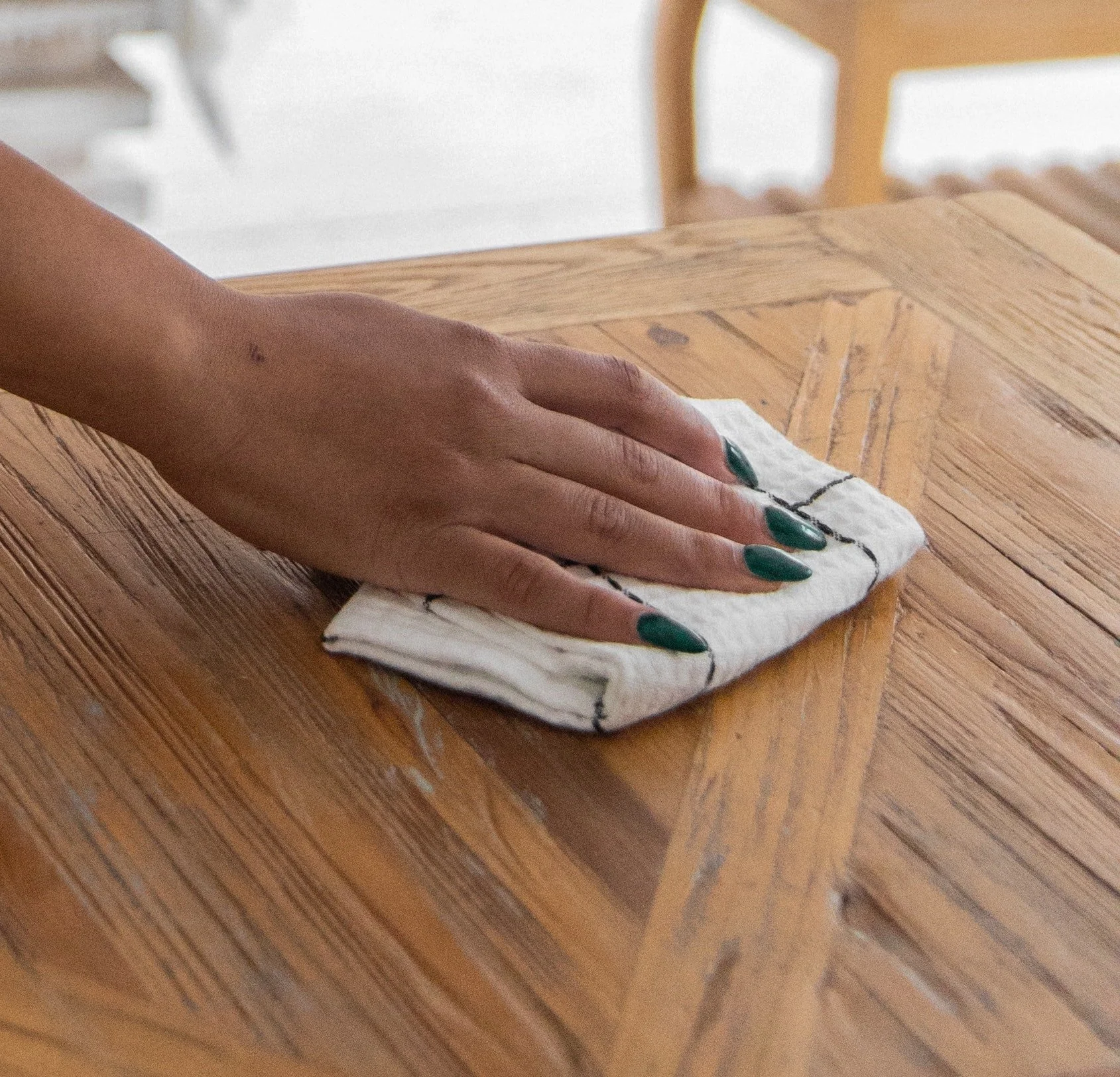Finding the right dining table for your home
A dining table is more than a surface for plates and cutlery. It’s where homework gets done, friends squeeze in for “just one more” coffee, and birthdays are quietly (or loudly) celebrated.
That’s why the style of your dining table matters. Not in a show-home, magazine way, but in a very real, everyday way. The shape of the top, the corners, the legs, the timber itself – they all change how the table looks, how it feels, and how you use it.
In this post, we’re talking only about timber dining tables, because that’s what we build and what we love.
Start with the shape
How do you like to gather?
Before you think about colours, finishes, or chairs, it helps to ask a simple question: How do you actually use your dining table?
Is it for long dinners with lots of people? Quick weeknight meals with kids? A mix of laptop, Lego and lunch? The shape of the table has a big impact on how well it supports all of that.
Rectangular timber tables
Rectangular is the classic for a reason.
Good for:
Long, narrow rooms
Larger families or people who entertain often
Using one side as a “work zone” and the rest for dining
What it feels like:
Structured, familiar, easy to place in most rooms
Great with benches on one or both sides
Easy to extend if you ever want a longer table down the track
You can keep it clean and minimal with straight edges and simple legs, or lean into a classic or farmhouse feel with chunkier legs and a slightly thicker top.
What it feels like:
Intimate, balanced, and symmetrical
A great option when you want the table to feel like a central “island” in the room
Square tables can look very modern with slim legs and a thinner top, or softer and more traditional with a slightly thicker top and rounded corners.
Round timber tables
Round tables are great when you want the room to feel open and flowing.
Good for:
Smaller spaces where you need to move around the table easily
Families with young kids (no sharp corners to bump into)
People who love long, chatty dinners – everyone can see and talk to everyone
What it feels like:
Friendly, relaxed, and welcoming
Softer on the eye, especially in rooms with lots of straight lines
Many round tables work beautifully with a pedestal or central base, which frees up legroom and makes it easier to squeeze in an extra chair when you need it.
Oval and rounded-rectangle timber tables
If you like the practicality of a rectangular table but want something softer, an oval or rounded-rectangle table is a lovely middle ground.
Good for:
Longer rooms that still need good walking space around the table
Homes where you want a more gentle, organic look
Families where safety and softness matter, but you still need seating for more people
What it feels like:
Gentle, calm, and a bit more “designed” without being showy
Easier to live with if you’re constantly walking past the corners
Corners and edges: small details, big difference
On a timber table, the edge profile makes a surprising difference to both safety and style.
Some options we often talk through with clients:
Sharp, square edges
Clean, modern, and crisp
Best for homes without small children (or for very careful kids)
Fully rounded corners
Great for young families and tight spaces
Helps the table feel more relaxed and approachable
Slightly eased edges
Still modern, but softer to the touch
A good in-between if you like straight lines but don’t want them too harsh
More sculpted profiles
Adds character and a handmade feel
Works beautifully with rustic or classic styles
Because we build everything by hand, we can shape the edges to suit how you live. If you say “my toddler runs into everything”, we’ll keep that in mind.
Leg and base styles
The legs and base do more than hold the table up. They change how many people can sit comfortably, what kind of chairs work best, and how the whole table feels in the room.
Four corner legs
The most traditional setup: one leg at each corner.
You can go with:
Straight timber legs for a simple, timeless look
Tapered legs for something lighter and a bit more mid-century
Turned legs for a classic or farmhouse feel (think gentle curves and details)
Pros:
Easy to understand and easy to place chairs around
Works with almost any table shape
Things to consider:
Chairs at the corners can sometimes “fight” with the legs if sizing isn’t planned properly – this is where custom design helps.
U-shaped or box legs
Good for:
Contemporary and minimalist spaces
Feel:
Clean, strong, and architectural
A nice way to introduce a darker element (for example, black painted timber) without making the table feel heavy
We always look at how far in to place the legs so your chairs slide in comfortably when not in use.
X-frame and cross legs
These can be used at the ends or as a central base.
Good for:
Rustic farmhouse or “modern barn” look
When you want the base itself to be a bit of a statement
Feel:
Characterful and eye-catching
Slightly more decorative than simple straight legs
With X-frames, planning the seating layout is important so no one ends up straddling a leg. That’s the sort of thing we sort out with you during the design phase.
Pedestal bases
Often seen on round or oval tables.
Good for:
Maximising legroom around a smaller table
Flexible seating – easy to pull up an extra chair
Both classic (with a turned pedestal) and modern (with a simple, straight design) looks
Feel:
Open, airy, and often a little more elegant
Great for conversations, because no one is stuck behind a leg in the corner
Classic, rustic farmhouse, or contemporary
You might have a rough sense of the style you’re drawn to, even if you don’t have the words for it yet. Here’s how shape and legs can work together to create different looks.
Classic elegance
Think timeless rather than trendy.
Shapes: rectangular, oval, or round
Edges: softened or gently profiled
Legs/bases: turned legs, refined trestles, or classic pedestal bases
Timber: rich grains, warm tones, and a finish that shows off the wood rather than hiding it
This style sits comfortably in older homes, formal dining rooms, or spaces where you want a touch of tradition without feeling stuffy.
Rustic farmhouse
Warm, sturdy, and ready for real life.
Shapes: rectangular or chunky square, sometimes with a thicker top
Edges: slightly softened, sometimes a more natural or “lived-in” feel
Legs/bases: farmhouse trestles, chunkier turned legs, or simple straight legs with a bit of heft
Timber: visible grain, knots, and character are welcome here
This is the style that says, “yes, you can put your elbows on the table.”
Contemporary
Clean lines and calm spaces.
Shapes: rectangular, square, round or rounded-rectangle
Edges: sharper or lightly eased for a modern feel
Legs/bases: U-legs, slim timber legs, or minimalist pedestal bases
Timber: can be light or dark, but usually with a smooth, even finish
Contemporary doesn’t have to mean cold. Solid timber keeps things warm and tactile, even in a modern space.
Getting the size and proportions right
Beautiful design isn’t just about how a table looks in a photo. It’s about how it fits your room and your life.
When we design a timber dining table with you, we look at:
Room size and layout
How much clearance you need to walk around the table comfortably
Number of people you want to seat most days
And how many you’d like to fit on special occasions
Chair style
Some chairs are wider or have arms, which changes the ideal size and leg placement
How you use the table day-to-day
Work, craft, homework, big family dinners, or all of the above
Because we work with 3D design, you’ll be able to see your table in the right shape, with the right legs, at the right size before we cut a single piece of timber. No guesswork, no “I hope this fits when it arrives.”
Looking after your timber table
Timber is wonderfully forgiving when it’s cared for properly. Scratches can often be softened or repaired, and a well-built timber table can last for decades.
We’ve put together a separate guide on how to maintain timber furniture, which walks you through day-to-day care and what to do if life leaves a mark or two.
For more information read our blog post about how to maintain timber furniture.
Designing a table that feels like it’s always belonged
Choosing a dining table isn’t just a box to tick on a furniture list. It’s choosing a piece that will sit at the heart of your home for years.
Whether you’re drawn to a round table with a central pedestal, a long farmhouse trestle, or a simple square table with rounded corners, we’ll walk you through every decision – shape, corners, legs, size, timber and finish.
We’ll sketch, measure, and show you a 3D design so you know exactly what you’re getting before we start building. And then we’ll do what we love most: handcraft a solid timber dining table that suits your space, your style, and the way you really live.
If you’d like to talk through ideas for your own dining table, just get in touch. We’re always happy to sit down, have a chat, and help you find the style that feels right at home.









